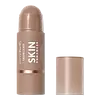Covergirl Trublend Skin Enhancer Balm Contour Stick Versus Wet n Wild MegaGlo Dual-Ended Contouring Stick
What's inside
What's inside
 Key Ingredients
Key Ingredients

 Benefits
Benefits

 Concerns
Concerns

 Ingredients Side-by-side
Ingredients Side-by-side

Caprylic/Capric Triglyceride
MaskingIsostearyl Neopentanoate
EmollientMica
Cosmetic ColorantPolyethylene
AbrasiveSynthetic Fluorphlogopite
Simmondsia Chinensis Seed Oil
EmollientKaolin
AbrasiveDicalcium Phosphate
AbrasiveSynthetic Beeswax
Emulsion StabilisingSynthetic Wax
AbrasiveAluminum Hydroxide
EmollientStearalkonium Bentonite
Gel FormingCalcium Sodium Borosilicate
Polyhydroxystearic Acid
EmulsifyingSilica
AbrasivePropylene Carbonate
SolventPentaerythrityl Tetra-Di-T-Butyl Hydroxyhydrocinnamate
AntioxidantPunica Granatum Pericarp Extract
Skin ConditioningTin Oxide
AbrasiveRubus Idaeus Leaf Extract
Skin ConditioningVitis Vinifera Fruit Extract
Skin ConditioningIron Oxides
CI 77891
Cosmetic ColorantCI 42090
Cosmetic ColorantCI 15985
Cosmetic ColorantCI 45410
Cosmetic ColorantCI 15850
Cosmetic ColorantCI 19140
Cosmetic ColorantCaprylic/Capric Triglyceride, Isostearyl Neopentanoate, Mica, Polyethylene, Synthetic Fluorphlogopite, Simmondsia Chinensis Seed Oil, Kaolin, Dicalcium Phosphate, Synthetic Beeswax, Synthetic Wax, Aluminum Hydroxide, Stearalkonium Bentonite, Calcium Sodium Borosilicate, Polyhydroxystearic Acid, Silica, Propylene Carbonate, Pentaerythrityl Tetra-Di-T-Butyl Hydroxyhydrocinnamate, Punica Granatum Pericarp Extract, Tin Oxide, Rubus Idaeus Leaf Extract, Vitis Vinifera Fruit Extract, Iron Oxides, CI 77891, CI 42090, CI 15985, CI 45410, CI 15850, CI 19140
Pentaerythrityl Adipate/Caprate/Caprylate/Heptanoate
EmollientPolyethylene
AbrasiveCetyl Ethylhexanoate
EmollientCaprylic/Capric Triglyceride
MaskingHydrogenated Coco-Glycerides
EmollientMethyl Methacrylate Crosspolymer
Dimethicone
EmollientParaffin
PerfumingBis-Behenyl/Isostearyl/Phytosteryl Dimer Dilinoleyl Dimer Dilinoleate
EmollientCera Microcristallina
Emulsion StabilisingCetyl PEG/PPG-10/1 Dimethicone
EmulsifyingPolyglyceryl-4 Isostearate
EmulsifyingHexyl Laurate
EmollientSorbic Acid
PreservativePhenoxyethanol
PreservativeAscorbyl Palmitate
AntioxidantTocopheryl Acetate
AntioxidantSilica
AbrasiveTocopherol
AntioxidantCI 77891
Cosmetic ColorantCI 77163
Cosmetic ColorantCI 77499
Cosmetic ColorantPentaerythrityl Adipate/Caprate/Caprylate/Heptanoate, Polyethylene, Cetyl Ethylhexanoate, Caprylic/Capric Triglyceride, Hydrogenated Coco-Glycerides, Methyl Methacrylate Crosspolymer, Dimethicone, Paraffin, Bis-Behenyl/Isostearyl/Phytosteryl Dimer Dilinoleyl Dimer Dilinoleate, Cera Microcristallina, Cetyl PEG/PPG-10/1 Dimethicone, Polyglyceryl-4 Isostearate, Hexyl Laurate, Sorbic Acid, Phenoxyethanol, Ascorbyl Palmitate, Tocopheryl Acetate, Silica, Tocopherol, CI 77891, CI 77163, CI 77499
Ingredients Explained
These ingredients are found in both products.
Ingredients higher up in an ingredient list are typically present in a larger amount.
This ingredient is an emollient, solvent, and texture enhancer. It is considered a skin-softener by helping the skin prevent moisture loss.
It helps thicken a product's formula and makes it easier to spread by dissolving clumping compounds.
Caprylic Triglyceride is made by combining glycerin with coconut oil, forming a clear liquid.
While there is an assumption Caprylic Triglyceride can clog pores due to it being derived from coconut oil, there is no research supporting this.
Learn more about Caprylic/Capric TriglycerideCi 77891 is a white pigment from Titanium dioxide. It is naturally found in minerals such as rutile and ilmenite.
It's main function is to add a white color to cosmetics. It can also be mixed with other colors to create different shades.
Ci 77891 is commonly found in sunscreens due to its ability to block UV rays.
Learn more about CI 77891Polyethylene is a synthetic ingredient that helps the skin retain moisture. It is a polymer.
It is also typically used within product formulations to help bind solid ingredients together and thicken oil-based ingredients. When added to balms and emulsions, it helps increase the melting point temperature.
Silica, also known as silicon dioxide, is a naturally occurring mineral. It is used as a fine, spherical, and porous powder in cosmetics.
Though it has exfoliant properties, the function of silica varies depending on the product.
The unique structure of silica enhances the spreadability and adds smoothness, making it a great texture enhancer.
It is also used as an active carrier, emulsifier, and mattifier due to its ability to absorb excess oil.
In some products, tiny microneedles called spicules are made from silica or hydrolyzed sponge. When you rub them in, they lightly polish away dead skin layers and enhance the penetration of active ingredients.
Learn more about Silica